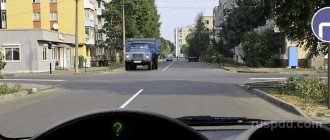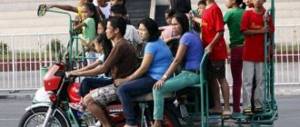Who is lobbying for increased speed on Russian roads?
Until 2009, there was only one government agency in Russia that was entrusted with the functions of managing federal roads - Rosavtodor, which is part of the Ministry of Transport of the Russian Federation. The total length of Russian highways of federal importance is no less than almost 51 thousand km.
And in the summer of 2009, special Federal Law No. 145 created another state structure in the field of road management, subordinate directly to the government of the Russian Federation -. Only 2.7 thousand highways are transferred to its management, among which the most “tasty” from the point of view of further commercialization are the M1, M3, M4, M11 highways.
Already now there are toll sections on the M1 and M4 highways, for which the truck driver pays Avtodor up to 400 rubles. Naturally, the higher the speed of movement, the greater the income of the state-owned company. That is why its management, back in December 2012, approached the traffic police with a proposal to max. The permitted speed on the highway was raised from the current value of 110 km/h to 130 km/h.
The traffic police responded by demanding guarantees that the roads controlled by Avtodor meet the “Highway” class according to GOST. This means the presence of four or more lanes 3.75 m wide with a central dividing strip and a multi-level intersection of other roads.
Speed and distance in figures and facts
Never rush. A skilled driver is, first of all, one who knows how to choose the speed in accordance with the road conditions. "Fast when possible, slow when necessary."
Now let's approach this topic practically. Regulations and restrictions on the speed limit in the traffic rules of the Republic of Kazakhstan are given not only in section Chapter 10 “Speed”, but are also given in other chapters that determine special traffic conditions, for example, passage through railway tracks, towing, transportation of people and goods, etc. .d. We will try to collect all this scattered information together - this will be a help for drivers and a training manual for those who are just preparing to become a driver. Let's start with the minimum number and then ascend.
And so: 8 km/h - if the speed of the vehicle according to the technical specifications is less than 8 km/h when passing through a railway crossing, it is permitted only with the agreement and permission of the head of the railway track.
20 km/h is the maximum speed for vehicles in residential areas.
30 km/h – In the area of sign 3.22 “Overtaking is prohibited”, overtaking of all vehicles is prohibited, except for single vehicles moving at a speed of less than 30 km/h.
– 3.21 overtaking is prohibited for trucks with a gross weight of more than 3.5 tons, except for single vehicles moving at a speed of less than 30 km/h.
40 km/h – On highways marked with sign 5.1, the movement of vehicles whose speed, according to their technical characteristics or their condition, is less than 40 km/h is prohibited. 9.5. Vehicles whose speed should not exceed 40 km/h for technical reasons cannot reach such a speed must move in the far right lane, except for cases of detour, overtaking, changing lanes, as well as for turning left, making a U-turn.
9.11. On roads outside the city, drivers of all vehicles whose speed should not exceed 40 km/h are required to maintain such a distance between their vehicle and the vehicle moving ahead so that vehicles overtaking them can easily change lanes to the previously occupied lane.
This rule does not apply during heavy traffic in an organized column.
50 km/h – The maximum permissible speed when towing motor vehicles.
60 km/h a) Maximum speed for all vehicles in built-up areas (indicated by sign 5.22 on a white background). b) The maximum permissible speed when transporting passengers in the back of a truck.
70 km/h – Maximum permissible speed outside the city
– trucks with a permissible maximum weight of more than 3.5 tons.
– passenger cars with trailers
– city and tourist buses, including those transporting groups of children.
90 km/h – Maximum speed – outside the city – cars with a permitted maximum speed of up to 3.5 tons, intercity buses, especially small buses. On highways - trucks with a gross weight of more than 3.5 tons, cars with trailers, city buses, tourist buses, including those transporting groups of children.
110 km/h – maximum permitted speed – on highways – for trucks with a maximum weight of no more than 3.5 tons. Intercity and minibuses.
In non-populated areas - cars and motorcycles.
140 km/h is the maximum permitted speed for cars and motorcycles on highways.
10.5 The driver is prohibited from:
– Exceed the maximum speed determined by the technical characteristics of the vehicle;
– Exceed the speed indicated on the “Speed Limit” identification sign installed on the vehicle.
– Obstruct other vehicles by driving unnecessarily at too low a speed.
– sharply unless necessary to prevent a traffic accident.
If the maximum speed exceeds the established technical specification, the vehicle may lose the necessary stability and controllability on the road. Parts of the engine and chassis may fail, or they may not be able to withstand the load of the tire.
By prohibiting movement unnecessarily at too low a speed, thereby interfering with other vehicles, the Rules mean that the vehicle is in good working order and there are no other factors preventing movement at the permitted speed.
Emergency braking in conditions may be unexpected for other drivers, so the Rules allow you to drive through a controlled intersection without resorting to emergency braking. At the same time, this requirement of the Rules does not prohibit drivers from using emergency braking in cases where it is necessary to prevent a traffic accident. The DRIVER must choose a distance such that in the event of sudden braking of the vehicle in front, a collision can be avoided. In the city it should be ½ the speed of movement, and outside the city - 1/1. Or speed 100 km/h distance 100 meters. Drivers, speed is a great advantage of a car; use this benefit correctly so that it does not turn into a detriment. Stay healthy and safe.
18 total today
Also interesting for you!
"Tricky" traffic lights
Requirements for the technical condition of vehicles. In questions and answers to help students...
Lessons in road ethics.
We discuss and comment on the new Rules.
The law came into force. Medical commission for driving school students according to the new rules. DVR...
Learn to drive the real way. Driver training is making building blocks for...
← Previous post
Next entry →
Leave a comment Cancel reply
Why the permitted highway speed of 130 km/h does not suit the Ministry of Transport
Then, at the beginning of 2013, representatives of the relevant ministry intervened in the matter and opposed this decision. The fact is that in addition to the concept of “permitted maximum speed on the highway,” which is mainly used by road maintenance workers and the traffic police, there is also the concept of “maximum design speed on highways.” It is used mainly by road designers and builders.
Under existing traffic rules and the Code of Administrative Offenses of the Russian Federation, drivers can, without fear of punishment, increase the speed above the maximum permitted by 20 km/h. It turns out that if the permitted speed on the highway is 110 km/h, then the actual speed at which vehicles can travel along it reaches 130 km/h, and if the permissible speed is up to 130 km/h, then its real value reaches 150 km /h. This is what designers and builders should be guided by.
Naturally, as this indicator increases, the costs of road construction increase. So the interests of various departments collided on this issue. Avtodor, which is directly controlled by the government, lobbied for an increase in speed, but the Ministry of Transport, which apparently supervises it, opposed this.
Fines for excess in 2021
According to the new initiative of the Safety Commission, the punishment for violating the speed limit will become more severe and the amount of fines will increase. The amount of the amount, as in 2021, will depend on the gap between the permitted and actual speed. If the speed is 20-40 km/h above the permissible limit, the fine will be about 3 thousand rubles. For exceeding the speed limit by 40-60 km/h you will have to pay 4 thousand rubles. Receiving the protocol again will threaten the violator with a fine of 5 to 10 thousand rubles. This bill is being finalized by the Commission, so the amounts are still approximate. Currently, the table of fines for speeding remains the same:
- 20-40 km/h – 500 rubles;
- 40-60 km/h – from 1000 to 1500 rubles;
- 60-80 km/h – from 2000 to 2500 rubles or deprivation of rights for a period of 4 months to six months;
- over 80 km/h – 5,000 rubles or deprivation of rights for six months.
If the violation is not the first, the amount of the fine increases. Here its size is determined by a specific inspector. For the same violations, one driver may be fined, and the other will have to surrender his license. It all depends on previous administrative penalties.
Although the new rules on the permissible threshold for exceeding the speed limit are not yet in effect, many are worried whether cameras installed on city roads and highways will be able to catch a difference of 10 km/h. Different devices read speed differently, so when the bill is finally adopted in the regions, it is dangerous for drivers to rely on camera errors.
The Prime Minister gets involved
The departments' litigation dragged on until the summer of 2013, until at the end of July Prime Minister Medvedev signed new changes to the traffic rules, which came into force in early August of the same year. Let us remember that it was he who signed the law on the creation of Avtodor in 2009. The changes established that for cars and trucks weighing up to 3.5 tons, road owners (Avtodor again!) could set the maximum permitted speed on the highway at 130 km/h. Such a road must be marked with signs 5.1 - “Highway”. The route, which is marked with signs 5.3 - “Road for cars”, allows the same vehicles to drive along it with a maximum permissible speed of 110 km/h.
Maximum speed outside the city
On highways, the maximum permitted speed depends on the characteristics of the road and the specific vehicle. Let's look at the acceptable speed limits:
- Motorway. Maximum – 130 km/h. To do this, an appropriate sign must be installed on the road section.
- An ordinary country road. For cars, motorcycles and minibuses, the maximum speed is limited to 90 km/h. If we are talking about category C trucks, large buses and vehicles with trailers - 70 km/h. For trucks carrying people and buses with children – 60 km/h.
How will the debate between supporters and opponents of increasing traffic speed end?
While the Russian budget in 2013 and the first half of 2014 was deficit-free, everything seemed to be going smoothly. Avtodor expanded the number of sections of its roads on which the speed limit on the highway increased, and Rosavtodor, part of the Ministry of Transport, on which 48 thousand km of Russian roads unnecessary to Avtodor remained “hanging”, tried to repair them and even build new sections. But the situation has changed due to sanctions against Russia. Funding for Rosavtodor was cut, but the order of the President of the Russian Federation to double the volume of road construction was not canceled.
At the end of March this year, the Ministry of Transport, through the mouth of Deputy Minister Oleg Belozerov and Deputy Head of Rosavtodor Igor Astakhov, again spoke about the need to reduce the estimated maximum speed from 150 km/h to 130 km/h. The Ministry of Transport refers to European standards, according to which roads whose class corresponds to the Russian Avtomagistral class are designed and built based on a vehicle speed of 130 km/h. The near future will tell how this dispute will end.
Bugatti Veyron Super Sport
bugatti.com
- Top speed: 431 km/h
- Acceleration dynamics from 0 to 100 km/h: 2.5 seconds
- Engine capacity: 8 l
- Engine power: 1200 hp
- Vehicle weight: 2200 kg
- Cost: 1.95 million euros
The Veyron Super Sport model was produced in 2010-2011, named after the legendary racing driver Pierre Veyron.
The supercar is equipped with an eight-liter turbocharged W16 gasoline engine with a power of 1200 hp. and automatic 7-speed transmission.
In 2010, maximum speed tests were carried out at the Volkswagen AG test site in Ehra-Lessin. On the first attempt, the supercar showed a result of 427.933 km/h, on the second the mark was recorded at 434.211 km/h. The result was an average result of 431 km/h, and at that time the Bugatti Veyron Super Sport became the speed record holder among production cars.
A total of 48 copies were produced.
How many highways are there in Russia?
So, in order for a highway to be able to travel at a speed limit of 110 km/h, it must be a motorway or expressway. The latter differs from a highway in the possibility of a single-level intersection with other roads. Of the total length of Russian roads of 51 thousand km, there are only 4-5 thousand km of routes of the above classes (the figures available on the Internet vary), or about 8%. Moreover, these are not full-length routes, but only individual sections of them. And the lion's share of them is concentrated in the state. Moreover, almost all sections where the speed limit on the federal highway is set at 110 or 130 km/h have already been made toll.
A pleasant exception to this rule was the free highway from Kemerovo to Leninsk-Kuznetsky, commissioned in August 2013, with a speed limit of 130 km/h.
General speed limits in the city
The general requirements establishing the permissible speed level in populated areas are defined in section 10 of the Road Traffic Regulations.
Clause 10.2 of this section of this document determines that the maximum permissible speed of vehicles in populated areas of any type, including cities, is currently not 60 kilometers per hour. At the same time, residential areas and courtyard areas inside populated areas are zones of a special speed limit: a maximum speed of no higher than 20 km/h is allowed here. The listed general speed limits must be applied immediately upon entering the relevant territory and throughout the entire period of stay in it. So, for example, if you are driving along a highway and see a sign indicating the beginning of a populated area, you should immediately reduce your speed to the permitted 60 km/h. The same should be done when a sign appears warning you about entering a residential area or courtyard area.
What is the speed limit on the M1 highway?
According to state data, for almost 450 km of the entire length of the route it corresponds to the “Highway” category. Along its entire length it is four-lane, and on the section 32-39 km (Odintsovo bypass) it is generally eight-lane. By the way, it is the 18.5 km section in the bypass area of this city that is made toll. A large infrastructure road junction at the federal level is being built here on a concession basis. The concessionaire is Main Road OJSC, and the concessionaire, naturally, is the state.
The maximum permitted speed of 110 km/h is set only on the free section of this highway from the 32.5 km mark to the 43.6 km mark between Odintsovo and Kubinka, Moscow region. By the way, on the territory of the Republic of Belarus, along the entire extension of this route, the speed limit is 120 km/h.
What do we have in the Urals?
The M5 federal highway runs from Moscow to Chelyabinsk through a number of regional centers in the Volga and Urals regions. For approximately 240 km, the highway has 4 or more lanes, but further on, having two lanes along the entire length, except for a few sections, it clearly does not resemble either a motorway or an expressway. In the summer of 2013, in the Chelyabinsk region, from the village of Vitaminnoye to the village of Misyash, a 24-kilometer four-lane section was opened, limited by signs 5.1 “Motorway”. In 2021, the section of the highway from Chebarkul to Chelyabinsk will also become four-lane.
Permitted speed on the M5 highway in sections from elevation. 1820 km to elevation. 1844 km and from elevation. 1022 km to elevation. 1031 km is set to 110 km/h. They plan to allow the same speed in sections from elevation. 86 km to mark. 124 km and from elevation. 37 km to mark. 57 km.
Which one is allowed?
In the city you can drive at speeds of up to 60 kilometers per hour, but a maximum of twenty is allowed in courtyards and parking lots.
You can get ninety outside a populated area, and one hundred and ten on the highway. The requirements for trucks are different. We have to take into account their mass and lower maneuverability than passenger cars, as well as a long braking distance. So a light (up to 3.5 tons) truck can reach 60 kilometers per hour in the city and no more than one hundred and ten outside it. For trucks and heavier cars, the requirements are even stricter - 60 kilometers per hour in the city and 70 outside the populated area. And on the highway you can score a maximum of 90.
For buses and other public transport
Trucks that carry people in the back can reach no more than sixty kilometers per hour. The same restriction applies to those transporting children.
If buses with children are sent, for example, to a place of study or recreation, this figure cannot be exceeded under any circumstances.
Table of speed limits on Russian roads
| Car category | driving speed in a populated area, km/h | driving speed outside the populated area, in km/h | highway speed, km/h | in a residential area, in km/h |
| Passenger car | 60 | 90 | 110 | 20 |
| With trailer | 60 | 70 | 90 | 20 |
| Category B truck | 60 | 90 | 110 | 20 |
| Category C truck | 60 | 70 | 90 | 20 |
| With passengers in the back | 60 | 60 | 60 | 20 |
| Intercity bus | 60 | 90 | 90 | 20 |
| Minivan (small bus) | 60 | 90 | 90 | 20 |
| Other buses | 60 | 70 | 90 | 20 |
| Bus for organized transportation of children | 60 | 60 | 60 | 20 |
For cars towing a mechanical vehicle, it is impossible to reach more than 50 km/h under any circumstances.
How fast can Russians drive along the Don?
What is the speed limit on the M4 highway? The M4 federal highway, with a total length of more than one and a half thousand km, is a four-lane highway in the section from Moscow to Voronezh. According to Avtodor, 918 km of the route correspond to the “Highway” class, 101 km – to the “Highway” class, 100 km – to the “Regular type road” class (a four-lane non-high-speed road with a central dividing strip).
Avtodor plans to turn the M4 highway into a completely four-lane highway with multi-level interchanges by 2021. The speed limit of 110 km/h is allowed on toll sections from elevation. 225 km to mark. 260 km (detour from Bogoroditsk), from elevation. 287 km to elevation. 321 km (detour of the city of Efremov) and 330-414th km (detour of the city of Yelets and the village of Yarkino), 414-460th km (detour of the city of Zadonsk).
In addition, the permitted speed on the Don highway is 130 km/h on the toll section - 48-71 km (in the Moscow region), as well as on free sections from mark. 113 km to mark. 120 km and from elevation. 76 to mark. 103 km.
Permissible speed outside city limits
Outside the city limits on highways and highways, the speed limit for vehicles of various categories is as follows:
- For cars and trucks weighing up to 3.5 tons, the maximum permitted speed on the highway is 110 km/h, and the permitted speed on the highway reaches 90 km/h.
- Motorcyclists and intercity buses on highways and highways are allowed to travel at a speed of 90 km/h.
- For route buses and cars with trailers, the speed on highways is 90 km/h and on the highway – 70 km/h.
- The speed limit for trucks carrying people and for all vehicles transporting groups of children on roads and highways is 60 km/h.
- The speed limit for vehicles towing other vehicles is 50 km/h on highways and highways.
What about this in the West?
What is the speed limit on highways in most European countries? Oddly enough, the numbers here are the same as in Russia - a maximum of 130 km/h. But the fact is that most of the roads are highways throughout their entire length. They bypass the boundaries of populated areas and do not have traffic light regulation. True, most of them are paid.
Germany deserves special mention. On some of its famous autobahns there is no speed limit at all, and 130 km/h is not the maximum allowed, but a recommended one, although still the maximum speed. But half of all German roads have strict speed limits of 80 to 130 km/h.
Maximum permissible speed in a populated area
For all settlements located on the territory of the Russian Federation, one speed limit has been introduced. The maximum speed on urban and rural roads is 60 km/h. But in addition to the basic limitation, there are additional ones. Let's look at them in more detail:
- towing vehicles – up to 50 km/h;
- traffic in the courtyard of a house or in a residential area – up to 20 km/h.
However, not all drivers follow the rules described above. Among Russian motorists, it is customary to add 10-15 km/h to the maximum limit. The fact is that exceeding the speed limit by 20 km/h is not subject to a fine. However, if the driver causes an accident, the inspector will take into account even a slight deviation from the norm.
Do Russians need to accelerate too much on the highways?
According to the classic of Russian literature, every Russian loves driving fast. But if he drives fast in an old Zhiguli, then trouble is not far away. Even if our driver is a used or assembled in Russia foreign car! After all, the quality of these cars and their maintenance are still far from the European level. And if we allow (in the future) Russians to accelerate on highways (the quality of which is also still in question) up to 150 km/h (taking into account the “twenty” that drivers add in their minds), then this is a direct threat to their lives and traffic safety.
Therefore, according to many auto experts, increasing the permitted speed for any country roads in Russia to 130 km/h is excessive and should be selective depending on the quality of each specific route.
SSC Ultimate Aero TT 2009
wikipedia.org
- Top speed: 421 km/h
- Acceleration dynamics from 0 to 100 km/h: 2.8 sec
- Engine capacity: 6.4 l
- Engine power: 1187 hp
- Vehicle weight: 1247 kg
- Cost: $1 million
The supercar produced by SSC North America is an updated version of the first SSC Ultimate Aero TT in 2007, produced in 2009-2011.
Equipped with a turbocharged Chevrolet Twin Turbocharged V8 gasoline engine, thanks to the use of a new power system, it was possible to increase power by approximately 19% (up to 1187 hp), engine capacity also increased to 6.4 liters.
The manufacturer predicted a top speed of more than 430 km/h, but during testing the supercar was only able to reach 421 km/h.
How do we punish those who drive too fast?
Unlike personal income tax, which remains at the rate of 13% for any individual’s income, the fine for excessive speed increases significantly as the offender “breaks away” from its maximum permitted value. So, if he “comes off” at 20-40 km/h, then the pleasure will cost half a thousand rubles, at 40-60 km/h - from one to one and a half thousand, at 60-80 km/h - from two to two and a half thousand rubles (or may be deprived of rights for six months), more than 80 km/h - five thousand rubles or deprived of rights for six months. Recidivities exceeding 60 km/h or more will lead to the loss of rights for a year, but if the violator was not caught by the inspector, but was only recorded by a video or photo recorder, then only a five thousand ruble fine can be given.
Fines for speeding in a populated area
The amount of the fine depends on how much the established speed limit was exceeded. The following sanctions are in effect in 2021:
- primary excess within 21-40 km/h – 500 rubles;
- if you repeatedly ignore the speed limit at 21-40 km/h, the amount will be the same;
- excess within 41-60 km/h – 1000-1500 rubles;
- repeated violation will entail an increase in the fine to 2,500 rubles;
- excess within 61-80 km/h – up to 2500 rubles;
- If a driver exceeds the speed limit by more than 81 km/h, he faces a fine of 5,000 rubles.
The fine can be reduced. In case of timely payment (within 20 days after discharge), the driver will receive a 50% discount.
If the driver has repeatedly violated traffic rules, the inspector may not limit himself to issuing a fine. The most common penalty for persistent violators is loss of driver's license for up to one year.











